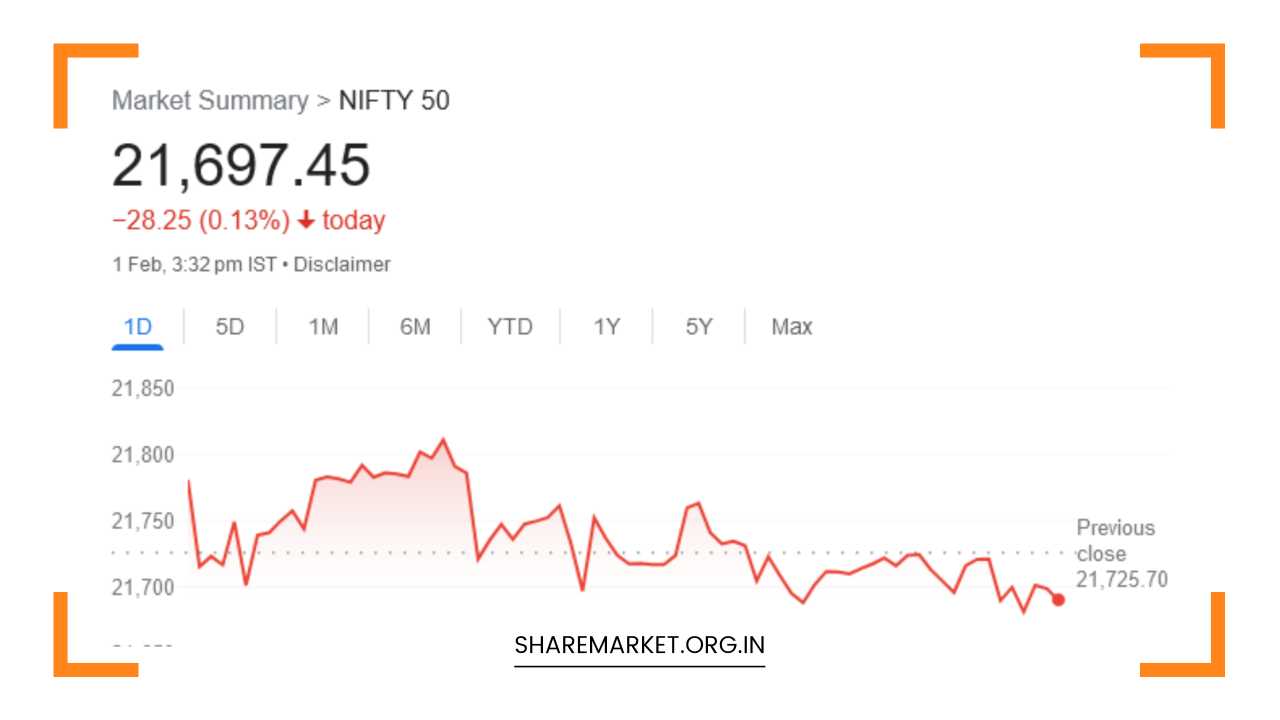Nifty Fell 28.20 Points to Close at 21,697; Nifty Prediction for Tomorrow

Nifty Prediction for Tomorrow
Analysis of Indian Stock Markets Post-Budget Day: Navigating Volatility and Selective Investments
The Indian stock markets displayed a cautious stance in the aftermath of the budget day on February 1, exhibiting a reluctance to commit to a definitive directional move.
In a trading session marked by volatility, the benchmark indices experienced a slight decline.
The Sensex concluded the day 0.15% lower at 71,645.30, while the Nifty closed 0.13% down at 21,697.50. A closer look at the market dynamics reveals nuanced trends, with implications for traders and investors.
Market Snapshot
Amid the fluctuations, 1467 shares closed with gains, 1762 faced losses, and 75 remained unchanged, reflecting the mixed sentiment among market participants.
The BSE Midcap index recorded a 0.4% decline, and the Smallcap index saw a 0.2% fall, indicating a broad-based impact on various segments of the market.
Notably, public sector banks faced a shortage following the announcement of measures aimed at reducing financial losses in the interim budget.
The budget outlined a target to maintain the fiscal deficit at 4.5% by the fiscal year 2026. This led to a more than 2% increase in the Nifty PSU index, underlining the market’s sensitivity to policy announcements.
Simultaneously, domestic bond yields dropped below 7%, contributing to the overall market dynamics. Despite these fluctuations, the day witnessed heightened volatility during the weekly expiry of Nifty, adding an additional layer of complexity for market participants.
Sectoral Performance
The performance of individual sectors provided a diverse picture. Top gainers on the Nifty included Maruti Suzuki, Cipla, Eicher Motors, SBI Life Insurance, and Power Grid Corporation.
Conversely, UltraTech Cement, L&T, Dr Reddy’s Laboratories, JSW Steel, and Grasim Industries emerged as the top losers, indicating sector-specific trends influencing market movements.
A closer examination of sectoral indices revealed a mixed trend. Auto, Bank, FMCG, and Power sectors witnessed increases ranging from 0.2% to 0.8%, showcasing relative resilience amid the market fluctuations.
In contrast, capital goods, metal, and realty faced a decline of one percent, highlighting the challenges faced by certain sectors.
Insights from Market Analysts
Ajit Mishra from Religare Broking provided valuable insights into the market behavior on the budget day. He noted that the market initially displayed positive trends but succumbed to profit booking around the previous swing high.
Despite being overbought, buying activity persisted, prompting traders to exercise caution and selectively place bets on quality stocks.
This nuanced approach reflects the delicate balance traders must strike between seizing opportunities and managing risks in a volatile market environment.
Kunal Shah of LKP Securities emphasized the strength displayed by Bank Nifty bulls on the interim budget day. The index closed above the 46000 level, indicating a positive trend in the banking sector.
Shah highlighted that the market trends were positive, with strong support for Bank Nifty at the 45800 level. He identified resistance on the upside at 46500, speculating that overcoming this hurdle might trigger intense short-covering in the market.
This analysis underscores the significance of sector-specific dynamics and technical levels in shaping market outcomes.
Aditya Gaggar, Director at Progressive Shares, offered a nuanced perspective on Nifty’s daily chart. He observed the formation of a small bearish candle but emphasized that the overall market sentiment remained bullish.
Gaggar identified support for Nifty at 21,630, coinciding with its 21DMA (21-Day Moving Average). On the upside, resistance was observed at 21,840.
This technical analysis provides traders and investors with crucial levels to monitor for potential market movements.
Strategic Considerations for Traders and Investors
In light of the market dynamics and insights from analysts, several strategic considerations emerge for traders and investors navigating the current scenario.
- Selective Investments: The cautious stance of the market suggests that investors should adopt a selective approach to their investments. Rather than making broad bets, the emphasis should be on identifying quality stocks with strong fundamentals.
- Sectoral Allocation: Sectoral performance diverged on the budget day, and this trend is likely to persist. Traders and investors should closely monitor sectoral indices, considering the varying impact of policy announcements and market dynamics on different sectors.
- Risk Management: The heightened volatility in the market necessitates robust risk management strategies. Traders are advised to set clear stop-loss levels and hedge their positions to mitigate potential downsides.
- Technical Levels: Technical analysis, as highlighted by analysts, plays a crucial role in navigating market movements. Monitoring support and resistance levels, as well as key moving averages, provides valuable insights for decision-making.
- Policy Sensitivity: The reaction of public sector banks to the budget’s financial measures underscores the sensitivity of the market to policy announcements. Traders and investors should stay abreast of policy developments and their potential implications for specific sectors.
Final Thoughts
In conclusion, the analysis of the Indian stock markets post-budget day reveals a nuanced landscape marked by volatility and sector-specific trends.
Traders and investors must exercise caution and adopt a selective approach in their investment decisions.
By closely monitoring sectoral dynamics, technical levels, and policy developments, market participants can navigate the complexities and position themselves strategically in a dynamic market environment.
The combination of analytical insights and strategic considerations forms a robust framework for decision-making in the evolving landscape of the Indian stock markets.

















